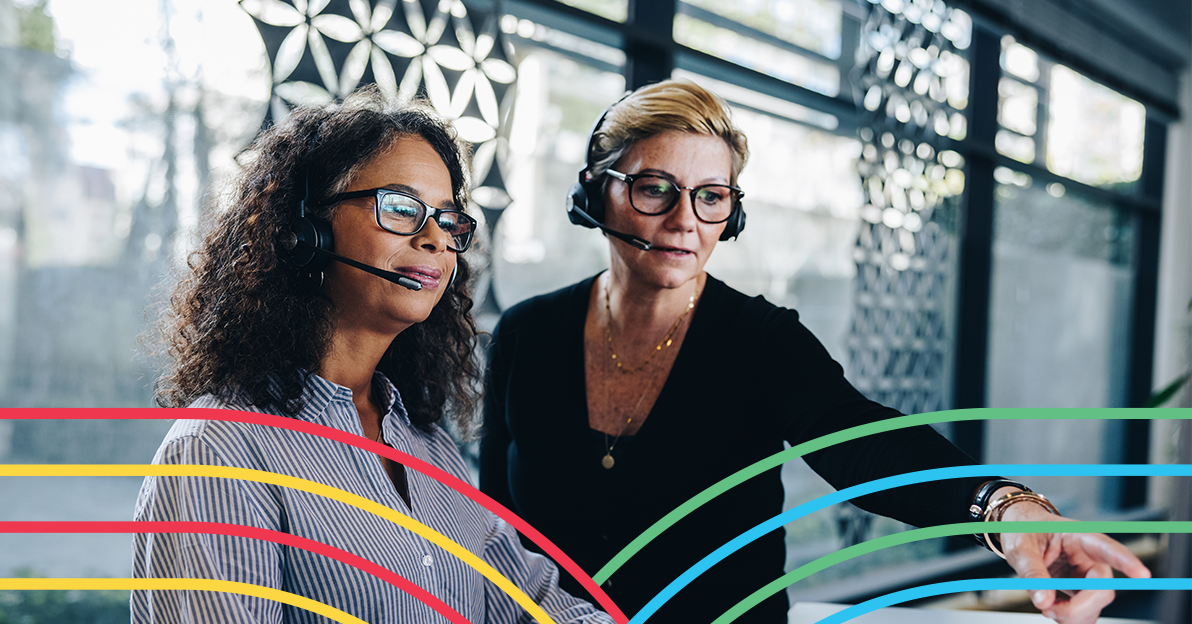Team building is one of the most important jobs for any manager. After all, unified and collaborative teams are exponentially more powerful than any one person alone. And one of the best ways for managers to bring teams together is by emphasizing communication and team-building activities.
But before you sign your team up for the latest escape room challenge, you should know a few things. While team-building activities can improve interpersonal dynamics and internal communication, you must connect them to the business.
Learn more about the importance of effective communication, the benefits of corporate team-building activities, and how Whole Brain® Thinking can improve them.
The Importance of Effective Communication in the Workplace
We’ve all seen how communication breakdowns lead to misunderstandings, frustration, and conflict. Communication isn’t easy, especially when people are getting to know each other or working through complex or contentious situations. And while people can improve, communication skills training alone won’t solve all your problems.
Adding to this challenge is that effective communication is a two-way street. It requires managers and employees to demonstrate good intentions and be clear about what they’re trying to communicate. In other words, effective communication isn't just about speaking clearly, but also about listening attentively and confirming understanding. Only when both parties do all these things can effective communication occur.
Bad communication isn’t just an inconvenience or a cost of doing business. It contributes to lower job satisfaction, productivity, and employee retention.
The Benefits of Effective Communication
Good communication lies at the heart of effective workplaces, trusting relationships, and the freedom to think big. Learn more about the benefits of communication and how it can show up in your team.
Improved Productivity And Performance
When employees can communicate openly and freely, they can easily exchange ideas and information. They can access information quickly and return to their pressing tasks. Open communication also means people are in the loop on to-dos, deadlines, and progress.
Effective communication also improves team performance because workers understand how their colleagues think and their strengths and weaknesses. This personal knowledge informs how people interact and use unique skills and thinking preferences to fill in gaps.
Reduced Workplace Conflict
Conflict can arise for many reasons, but one form is when employees feel they can’t communicate well. They struggle to raise important issues or give constructive feedback. They avoid conflict, letting their emotions build until they lash out.
Effective communication empowers team members to have direct, open, and honest conversations, even about difficult situations. Because they can solve problems and misunderstandings by communicating and finding common ground, employees are less worried about “winning” the conversation.
Improved Decision-Making
Decisions are improved through effective communication because people are more likely to have all the information they need — and they’ve felt more free to discuss a range of ideas. Instead of someone on the team feeling afraid to share their unorthodox but promising opinion, they speak up, and the team’s ultimate decision is elevated.
Stronger Relationships
Sign up to our newsletter for the latest insights
Strong co-worker relationships also improve team thinking because employees are more willing to collaborate. They build on their shared knowledge and camaraderie to achieve outcomes that a group of strangers wouldn’t.
%20(1).png?width=1200&height=627&name=HerrmannBlog_CommunicationTeamBuildingActivities_InteriorImageA%20(1)%20(1).png)
4 Great Work Team-Building Activities
Good team communication skills don’t happen overnight. Even the most successful communication strategies take time and require everyone’s involvement. One approach to improving workplace communication is by using team-building activities. Here are four popular options.
The Elephant List
This game helps teams face the proverbial “elephant” in the room. The Elephant List is a communication activity designed to help teams be candid about taboo workplace topics.
This activity proceeds as follows:
-
If you are in-person, give each team member a piece of paper or sticky note. Then give your team five minutes to write down their “elephant.” For remote employees, use a shared spreadsheet such as Google Sheets or Microsoft Excel.
-
The activity leader will collect the responses and share them with the team anonymously.
-
Work through these “elephants” to determine the most critical issues, how they might be resolved, and whether they can be resolved at the moment.
This activity allows people to surface workplace issues that they believe are unaddressed, but in a safe environment where people are willing to listen and help.
Word Association
Word association games are an excellent way for employees to learn about their teammates’ experiences and perspectives.
To play the game, your team has to:
-
Break into groups. Each group has a leader who will write down or say the words aloud to the group.
-
Ensure that everyone grabs a pen and paper or a computer to write or type the words.
-
The group leader reads words aloud, usually over five to 10 minutes, with each group member writing down the first thing that comes to mind when they hear each word.
-
The group then shares what they wrote down for each word and discusses their reasoning.
This activity can help team members to iterate quickly. Sorting through those ideas together reinforces the power of team collaboration.
Blind Drawing
This activity helps teams trust each other and practice their communication skills. One person is tapped to draw an image, but they can only rely on instructions communicated by their teammates. If you’re looking for online team-building activities, this game also translates well to a remote environment.
To get started:
-
The activity leader should build a list of images.
-
Break into small groups (pairs are fine, but so is a group of four or five).
-
The person selected to draw isn’t allowed to speak or see the image; only the other participants can see the image.
-
The other participants must give the drawer instructions. After a few minutes, call time, and share the drawings with the entire group.
By the end of this activity, team members will see how well they've communicated their instructions. You’ll also learn how the person drawing interpreted those directions and where they added their creativity.
Card Pieces
This activity helps teams tap into empathy and improve their negotiation skills. This activity is excellent for small groups.
To play, your team has to:
-
Take a deck of cards that you don’t mind damaging. Pull cards from the deck and cut them diagonally into two triangles. Cut those pieces diagonally until you have four pieces.
-
Divide the card pieces among the groups by placing the pieces into envelopes. Make sure to shuffle the card pieces before dividing them up.
-
Give the groups a few minutes to try and put the pieces together.
-
Next, encourage the groups to barter with each other so they can reform the cards into their original compositions.
-
When time is up, the team with the most completed cards wins.
This activity encourages your people to work together to complete a task. They must communicate, think visually, and negotiate with other teams to achieve the best outcome.
These are just a sampling of the team meeting ideas and activities that help people improve their communication skills and get to know each other better.
%20(1).png?width=1200&height=627&name=HerrmannBlog_CommunicationTeamBuildingActivities_InteriorImageB%20(1)%20(1).png)
How to Introduce Work Team-Building Activities With Whole Brain® Thinking
The Whole Brain® Thinking model is an advanced representation of people’s thinking preferences. It’s visualized in four quadrants: Analytical (Blue), Structural (Green), Relational (Red), and Experimental (Yellow). Each quadrant is distinct but equally important — and every person can use each of them in their work and interactions.
When selecting work team-building activities, understanding your team’s Whole Brain® Thinking profiles can inform what you have your people focus on. Before hosting communication-focused team-building activities, have your team take the Herrmann Brain Dominance Instrument (HBDI)® Assessment. With access to each individual HBDI® profile (and the team’s overall profile), employees gain a better sense of their co-workers’ thinking and can be more intentional in their interactions.
For example, if your team is heavily analytical (Blue) and structural (Green), you might start with team-building activities that include facts, figures and processes. That gives your people a foundation they’re comfortable with. As they undertake the activity, they’ll be pushed to also access their interpersonal (Red) and experimental (Yellow) thinking. While everyone can and should use all four quadrants, you can help your team by starting from their favorite thinking preferences.
When choosing activities, also consider the size and makeup of your team, and where you’ll be conducting these activities. For example, small teams might benefit from activities that can be done collectively, while large groups need breakout sessions. Whether you’re in person, remote, or hybrid will also affect how these activities are organized.
How to Integrate Thinking into Team-Building Activities
After winning buy-in for team-building activities, Whole Brain® Thinking can continue to influence how you facilitate these activities.
Set the Stage
One way to think about Whole Brain® Thinking is in terms of addressing four areas: What (Blue), How (Green), Who (Red), and Why (Yellow). For example, everyone will wonder who must participate and why. But people whose thinking preference trends to Red might be especially interested in the interpersonal dynamics.
Ensure you’re communicating the specifics of the activity, what you hope to accomplish, why it’s essential, and who benefits. And be prepared for follow-up questions that dig into each of those areas.
Give the Team Tools to Put Its Brainpower to Work
While many team-building activities are simple games or exercises, your team needs the right tools to succeed. If you’re selecting a team activity requiring movement, you’ll likely want to have people in the office.
As you design these activities, use a Whole Brain® prism to ask important resource-related questions. For example:
-
Green: Have you created easy-to-follow instructions?
-
Blue: Is it clear how your team will understand that they’ve completed the activity? Do they know what the goal is?
-
Red: Have you accounted for where your people live and work? For example, is your activity compatible with remote work?
-
Yellow: Will the activity unfold in a straight line, or are you seeking iterative and experimental thinking? Does your team understand the larger purpose of the activity?
Build Whole Brain® Communication Skills
The goal of these activities is to improve the communication skills of each person. This is where the principles of Whole Brain® Thinking can be brought to bear. For example, everyone’s HBDI® profile also has an “under pressure” score that illustrates how their thinking preferences change during stressful situations.
Consider team-building activities that force people to make decisions quickly, such as a word association game or solving a puzzle under a deadline. Your team will get to practice handling discomfort without the consequences of real-world failure.
You might even revolve the stress activity around the HBDI® “under pressure” score. In such an activity, each team member spends a few minutes exploring how their thinking shifts under stress — including ways this shift might cause stress for others.
After everyone identifies areas they want to remember or act on, break out into small groups of two or three people. Each group discusses their reflections. They also develop action items for improving their stress responses or how they can help the team work better under pressure.
Best Practices for Hosting Activities and Measuring Results
Team-building activities can spark engagement, excitement, and better thinking, but they only succeed when they’re run well and align with the business. Here are the best practices to get you started.
Set Measurable Goals
What do you want to achieve with these activities? Do you want to improve communication between employees? Increase trust? Resolve conflict? Having a clear goal helps you choose the right activities. Crushing one important goal is better than trying to achieve several goals and completing none.
Align Team Members on Goals and Individual Contributions
It’s not enough to tell your team, “We’re doing this activity to improve communication.” Your people need to know what that improvement looks like in their daily work lives. Address Red questions around each person’s responsibilities and Blue questions around metrics for success.
If your team is pursuing individual or company goals as part of their employee development plans, see how you can connect these activities to their goals.
Follow Up After the Activity
One of the challenges of stopping day-to-day work for a meeting, conference, or team-building activity is keeping the momentum going afterward. It’s all too easy to have a great time, then return to your desk and forget the lessons learned.
Make sure to include a debriefing, either at the end of the team-building activities or soon after, to allow everyone to reflect on what happened. And decide on action steps: With what everyone has learned about themselves and their co-workers, what will they do differently?
%20(1).png?width=1200&height=627&name=HerrmannBlog_CommunicationTeamBuildingActivities_InteriorImageC%20(1)%20(1).png)
Improve Team Communication Together
Effective communication in the workplace must be considered. By investing time and energy in these activities, organizations can unlock the potential of their teams, create stronger relationships, and develop a sense of shared purpose.
Improving communication with team-building activities helps employees build trust and understanding with their co-workers. Teams with high levels of trust can work through conflict, think more effectively, and produce better outcomes.
Learn how these team-building exercises will prepare your team to dominate.


.png?width=1200&name=HerrmannBlog_CommunicationTeamBuildingActivities_Featuredimage%20(2).png)









